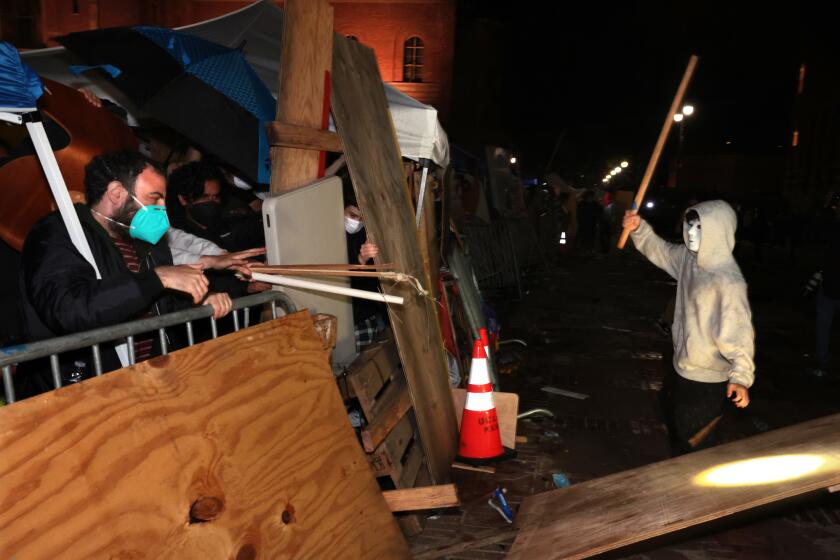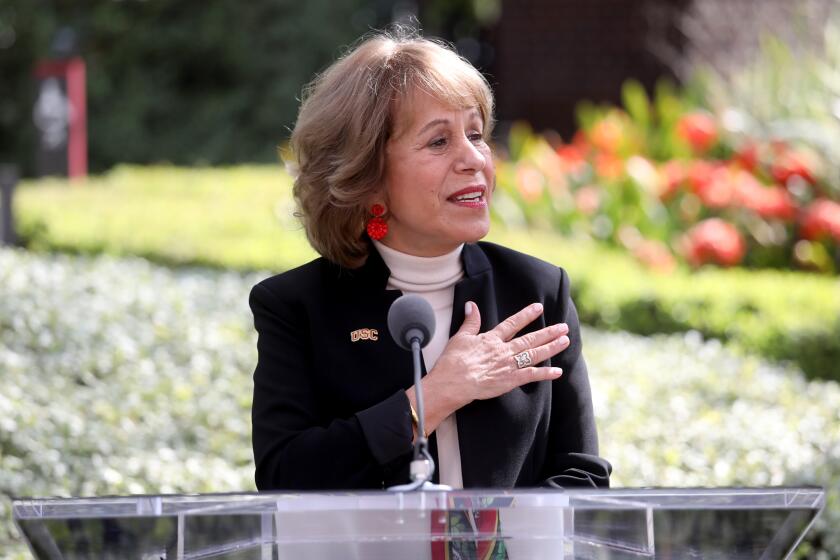Game Plan Seeks Elite Students
Something strange happened at UC Irvine this year: The basketball team got good. Real good. A couple of professors there have won Nobel Prizes, and many of its academic programs are ranked among the best in the country. But basketball? Who did they think they were, UCLA?
They can aspire.
The blossoming of the school’s basketball squad into one of the top teams in the Big West conference was no coincidence.
It was part of a plan Chancellor Ralph Cicerone launched shortly after his appointment three years ago, which included raising hundreds of thousands to send the team on a preseason tour of Canada, to improve training facilities and to keep athletes on campus during the summer.
A quiescent student body has turned into a bunch of maniacally screaming fans at the games.
But Cicerone’s plan has a more important goal than putting an athletic weakling on a Charles Atlas program.
He views sports as giving the university a higher national profile while providing students with more activities in a bleak campus social scene. And a better social life means an easier sell to the elite students the school wants to attract.
Cicerone isn’t finished, either. UC Irvine is spending millions to rebuild its baseball field in time to reintroduce the sport in January, and he hopes to raise the money to expand the centers for sports medicine and strength and conditioning.
Because college sports are more than just games, Cicerone isn’t the only one with this idea. Thirty miles east along the Riverside Freeway, UC Riverside Chancellor Ray Orbach has embarked on a similar path.
It’s no coincidence that the two chancellors came from schools known for their combination of athletics and academics, Cicerone from the University of Michigan and Orbach from UCLA.
“The chancellor felt if we’re going to be a fabulous academic environment, we need to do everything at the highest level,” said Riverside Athletic Director Stan Morrison, a former USC basketball coach. “If you’re going to the prom, you don’t wear flip-flops.”
Experts are divided on whether successful teams--in marquee sports like basketball and football--make it easier to raise money for academic programs and to attract smarter students.
“Do athletics make a difference on campus? Yes they do,” said Stanley Ikenberry, president of the American Council on Education. “They’re a great community builder. Alumni, students and townspeople bond together and have a sense of identity through athletics they might not have had.”
But does it lead to more donations and more applications?
“There’s no evidence to support that,” he said. “Successful athletic programs do tend to generate more donations to athletic programs but not necessarily to the university itself.”
Still, experts point to universities that have received a boost in their national profiles from sports. The best examples, they say, are Georgetown and Duke, which already had reputations for strong academics. It wasn’t until their basketball teams became perennial winners, though, that they became nationally known universities.
No one can deny the publicity that sports provide a university. A major sports program gets day after day of stories in the local newspapers and on TV, while the university’s scholars get next to nothing. Alumni maintain connections to their schools by following sports.
“It’s a basic kind of brand awareness,” said Robert Pringle, director of development marketing at Stanford University.
UC Irvine has had its share of good teams through the years, usually in such minor sports as water polo and tennis.
But when the recession in the early 1990s hit, budget cuts meant $500,000 trimmed from its athletic programs. Baseball was dropped. Athletes transferred in droves.
The college fell to the bottom 6% of NCAA Division I schools in the number of athletic scholarships it awarded.
When Cicerone was appointed chancellor in 1998, he decided the campus culture needed a jolt. He knew from his years as a professor and dean that student life on campus was dull. There is no surrounding college town as in Berkeley, Cambridge or Westwood, where myriad cultural activities are close. So many students leave on weekends that the campus can be a ghost town.
Said the Princeton Review college guide: “If suburban diversions excite you, there’s Irvine.”
Within weeks of Cicerone’s becoming chancellor in July 1998, he and Athletic Director Dan Guerrero turned for help to the Chief Executive Roundtable, a UCI support group of about 80 prominent Orange County business executives, including Henry Nicholas and Henry Samueli of Broadcom, Richard Sim of the Irvine Co. and Charles Haggerty of Western Digital Corp.
Members pay $12,500 each in annual dues. Cicerone told them that as the university competed for better students, it needed to improve the quality of its social life.
“We’ve become more selective, and we have to compete,” Cicerone said. “We’re dealing with students who are being admitted to a lot of very good places that have even more to offer than we do.”
The group has raised $100,000 for the basketball team in each of the last three years with a halftime free-throw contest. The fund-raiser has included pledges for each basket Cicerone hits. He never told the CEOs he had once made 88 in a row in high school.
In 1999, the athletic program received its most important boost when students voted to tax themselves $33 per quarter, with most of the money going to the intercollegiate athletic program.
The referendum paid for the university to add women’s indoor track, women’s golf, and baseball and water polo. It also provides $1.5 million a year for scholarships, allowing UC Irvine to offer the maximum number of scholarships in each sport. That and the free-throw money from the CEOs paid for the 10-day Canadian trip and summer season for the basketball team for extra training.
At the same time, the school’s expanded athletic marketing department went to work getting students involved.
The marketers joined with the student government to form the CIA (Completely Insane Anteaters), gave them yellow shirts--the school colors are blue and gold--and encouraged their antics.
What helps attendance most is a winning team, and that’s what the school got: a team that won the regular season conference championship, played in the National Invitation Tournament and went 25-5.
Next up for Cicerone and Guerrero is the baseball team, which will begin play in January. The $10-million stadium is being rebuilt in an effort to make it one of the best college fields in the country. The first stage is expected to be completed in November.




